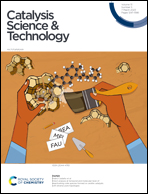Photo-Fenton-induced selective dehydrogenative coupling of methanol into ethylene glycol over iron species-anchored TiO2 nanorods†
Abstract
It is fascinating yet extremely challenging to cleave inert aliphatic C(sp3)–H bonds to form carbon–carbon (C–C) bonds directly under environmentally friendly conditions. Due to the highly complex bonds of organic molecules and the low reactivity of C(sp3)–H bonds, the selective activation of an inert C–H bond is typically difficult. Derived from various carbon resources, methanol (which has versatile chemical bonds) can serve as a superior renewable one-carbon feedstock for the large-scale production of fine chemicals. Herein, we choose methanol as a model molecule of aliphatic alcohols and demonstrate that inert aliphatic C–H bonds can be selectively fractured to form hydroxymethyl radicals (˙CH2OH) by hydroxyl radicals (˙OH) from the photo-Fenton reaction over iron species-anchored TiO2 nanorods (TiO2/FeOx nanorods). Subsequently, ethylene glycol is generated through C–C coupling of the hydroxymethyl radicals (˙CH2OH). Benefiting from the synergistic effect of the Fenton and photocatalytic mechanisms, the dehydrogenative C–C coupling of methanol is highly efficient with TiO2/FeOx nanorods as photocatalysts, with the formation rate of ethylene glycol up to 37.8 mmol h−1, selectivity higher than 78% and the methanol conversion rate up to 95.5 mmol h−1. This work efficiently utilizes methanol and offers an atomically economical and green methodology for the selective functionalization of an inert aliphatic C(sp3)–H bond.



 Please wait while we load your content...
Please wait while we load your content...